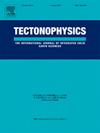Southernmost Kerguelen Plateau – Not a continental fragment
IF 2.6
3区 地球科学
Q2 GEOCHEMISTRY & GEOPHYSICS
引用次数: 0
Abstract
Most models on the early continental drift of the Indian continent from Antarctica are guided by the existence of microcontinents that are supposed to be located beneath Elan Bank and the Southern Kerguelen Plateau in the Enderby Basin off East Antarctica. Two deep seismic lines were acquired to test these ideas by investigating the distribution of oceanic and continental crust in the Enderby Basin. In this contribution, we discuss the results of the eastern profile which images the crustal structure of the southernmost Kerguelen Plateau. The new deep seismic data show that the seismic velocity structure of the southernmost Kerguelen Plateau is different to that of extended continental crust but similar to other igneous oceanic plateaus worldwide. At the northern end of the profile, the Moho discontinuity lies at a depth below sea level of approximately 25 km. The position of the East Antarctic continent-ocean boundary is located close to its continental shelf edge. The maximum thickness of the East Antarctic transitional crust, at the southern termination of our line, is 22 km. Extrapolating our seismic reflection and refraction results show that the oceanic crust at 50° - 90°E in the Enderby Basin and Princess Elizabeth Trough formed whilst in receipt of excess melt from the Kerguelen plume around magnetic chron M4n causing a northward thickening of the oceanic crust since 130 Ma. These results strongly support a one-phase model for the drift of the Indian plate.
最南端的克格伦高原——不是大陆碎片
大多数关于印度大陆早期从南极洲漂移的模型都是由位于东南极洲恩德比盆地的Elan Bank和南部Kerguelen高原下的微大陆的存在所指导的。通过研究恩德比盆地洋壳和陆壳的分布,获得了两条深地震线来验证这些想法。在这篇文章中,我们讨论了描绘克格伦高原最南端地壳结构的东部剖面的结果。新的深部地震资料表明,克格伦高原最南端的地震速度结构与伸展大陆地壳不同,但与世界上其他火成岩海洋高原相似。在剖面的北端,莫霍断裂带位于海平面以下约25公里的深度。南极东部大陆-海洋边界位置靠近其大陆架边缘。南极东部过渡性地壳的最大厚度,在我们线的南端,是22千米。外推我们的地震反射和折射结果表明,恩德比盆地和伊丽莎白公主海槽50°- 90°E的海洋地壳形成于大约磁年轮M4n前后的Kerguelen羽的过量熔融,造成130 Ma以来海洋地壳向北增厚。这些结果有力地支持了印度板块漂移的单相模型。
本文章由计算机程序翻译,如有差异,请以英文原文为准。
求助全文
约1分钟内获得全文
求助全文
来源期刊

Tectonophysics
地学-地球化学与地球物理
CiteScore
4.90
自引率
6.90%
发文量
300
审稿时长
6 months
期刊介绍:
The prime focus of Tectonophysics will be high-impact original research and reviews in the fields of kinematics, structure, composition, and dynamics of the solid arth at all scales. Tectonophysics particularly encourages submission of papers based on the integration of a multitude of geophysical, geological, geochemical, geodynamic, and geotectonic methods
 求助内容:
求助内容: 应助结果提醒方式:
应助结果提醒方式:


